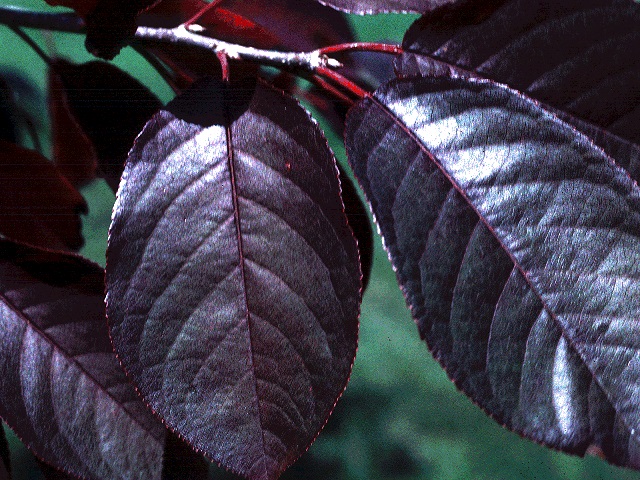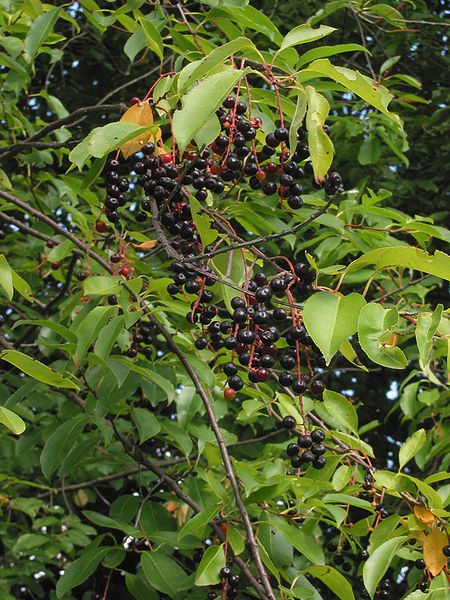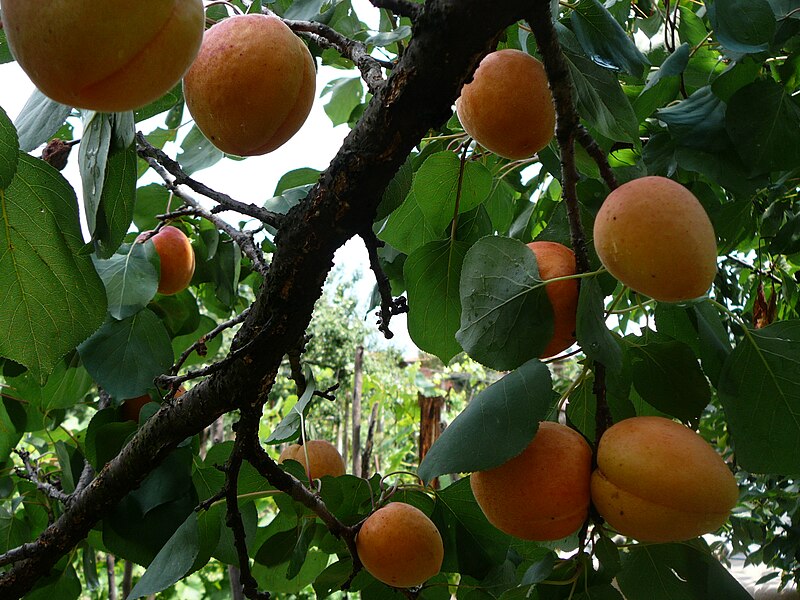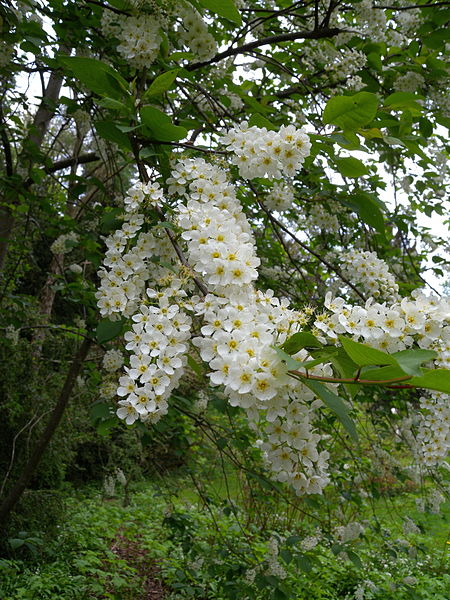New Account | Seed Mix |
Gift Certificates |AAS Winners |
Gardening Products
SEEDS: Unusual | Annuals | Perennials | Vegetables | Herbs | Trees
Cherry Tree Seeds
Important Note: Most of the seeds on this page will
benefit greatly from using the Cold Stratification Kits that we use in our own
greenhouses. We find we receive significantly better and faster
germination results when we use this on prunus seeds.

Image: By Matt Lavin from Bozeman, Montana, USA (Prunus virginianaUploaded by Tim1357) [CC BY-SA 2.0], via Wikimedia Commons
TRZ153 Wild Black Cherry ( Prunus Virginiana )
For zones 2-6. A medium size cherry tree; height usually not
over 20 to 25 feet, diameter 4 to 8 inches; with an irregular,
rounded crown. Bright green, broadly oval leaves, paler
underneath; length 3 to 4 inches, width 1 to 2 inches. Fruit is
in dense clusters; reddish, turning nearly black when fully
ripe; each berry containing a single seed, skin of fruit thick;
flesh thin and dark; very astringent to the taste, but edible.
Popular tree for birds. Most widely distributed tree in North
America, extending from the Arctic Circle to Mexico and from
the Atlantic to the Rockies.

Image:fwschumacher
TRZ053 Schubert Chokeberry ( Prunus virginiana Shubert )
'Schubert', sometimes called purpleleaf chokecherry, is a deciduous, suckering tree or shrub with a pyramidal habit which grows 20-30' tall. It is best known for its purple foliage: elliptic to obovate leaves to 5" long emerge green in spring, gradually maturing to dark purple by early summer.
This deciduous plant is a great addition to any garden as it attracts birds and butterflies and can be used as a specimen, shrub border, or informal hedge. It is fairly adaptable; it can thrive in full sun or part shade and in dry to medium moisture, well-drained soils. Shubert Chokecherry is also rich in antioxidant pigment compounds and can be used to make delicious jams, jellies, or syrups. Grow the Schubert Chokecherry in your garden and enjoy its stunning beauty and tasty fruit!
Grows well in zones 2-7.
This deciduous plant is a great addition to any garden as it attracts birds and butterflies and can be used as a specimen, shrub border, or informal hedge. It is fairly adaptable; it can thrive in full sun or part shade and in dry to medium moisture, well-drained soils. Shubert Chokecherry is also rich in antioxidant pigment compounds and can be used to make delicious jams, jellies, or syrups. Grow the Schubert Chokecherry in your garden and enjoy its stunning beauty and tasty fruit!
Grows well in zones 2-7.

PR08 Wild Black Cherry ( Prunus serotina )
A fast growing cherry for zones 2-8. Grows in pyramidal to
conical shape 50-75 feet tall. Leaf: 2 to 5" alternate, simple
leaves; yellow to red fall color. Flower/Fruit: 4 to 6" raceme
of white flowers in early spring; small juicy reddish black
edible berries in summer that attract birds.

Image:Elena Chochkova, CC BY-SA 3.0, via Wikimedia Commons
TRZ171 Mandshurian Apricot ( Prunus armeniaca
var. mandshurica )
Looking for a beautiful and unique tree that can add a touch of color to your garden or orchard? Consider Prunus armeniaca var. mandshurica, also known as the Mandshurian Apricot. This small tree can reach heights of 8-12 meters, with a dense canopy and a trunk up to 40 cm in diameter. The leaves are ovate with a finely serrated margin and the flowers are white to pinkish with five petals. They bloom in early spring, often before the leaves appear.
Manchurian apricot is typically planted in the landscape for ornamental purposes rather than for fruit harvest. It is now being planted in a number of cold winter areas because of its excellent winter hardiness to USDA Zone 3. Fruits can be used to make flavorful jams and jellies. Flowers are ornamentally attractive in spring.
So why not add the Mandshurian Apricot tree to your yard today? With its unique fruit and delicate flowers, it is sure to be a dazzling addition to any landscape. Best suited for zones 3-8.
Manchurian apricot is typically planted in the landscape for ornamental purposes rather than for fruit harvest. It is now being planted in a number of cold winter areas because of its excellent winter hardiness to USDA Zone 3. Fruits can be used to make flavorful jams and jellies. Flowers are ornamentally attractive in spring.
So why not add the Mandshurian Apricot tree to your yard today? With its unique fruit and delicate flowers, it is sure to be a dazzling addition to any landscape. Best suited for zones 3-8.

Image: Sheffields
TRZ172 American Plum ( Prunus americana )
In our opinion, nothing is better than eating a fresh plum directly off the tree! The American Plum is a fast growing selection with many uses. This plum will grow as a small tree or large shrub which will readily sucker from the ground up around the root zone. When suckers are not trimmed regularly, it will transform into a large erect shrub and form a dense spreading thicket as it ages. In the spring, clusters of 1" white flowers will form, usually some of the first flower blooms in the woodlands. Fruit will form over summer, and mature in August and September. The plums can be used in jellies, preserves, and even eaten raw.
Prunus americana thrives in USDA hardiness planting zones 3 to 8 and prefers thicket, open field, or woody habitats which get at least 16" of rain per year and is often seen along roadsides and in pastures. It does best in well-draining soil and is a good choice for windbreaks and general landscaping beautification. Due to its bushy, slightly tangled foliage structure, this tree is a great choice to add visual interest to any yard.
Prunus americana thrives in USDA hardiness planting zones 3 to 8 and prefers thicket, open field, or woody habitats which get at least 16" of rain per year and is often seen along roadsides and in pastures. It does best in well-draining soil and is a good choice for windbreaks and general landscaping beautification. Due to its bushy, slightly tangled foliage structure, this tree is a great choice to add visual interest to any yard.

TRZ152 Nanking Cherry ( Prunus tomentosa )
Best for zones 2 to 7, grows to 8 ft, spread 8 ft. Rounded, deciduous shrub with white flowers and red fruit. Nanking Cherry can be used in the shade, but it flowers better
in sun or partial shade. The flowers are borne briefly in early spring and are pale pink, fading to white. The red fruits are sour and eaten by birds. The plant is often
purchased by homeowners as a smaller substitute for tart
cherry.

Image: By MurielBendel [CC BY-SA 4.0], from Wikimedia Commons
PR14 European Bird Cherry ( Prunus padus )
European birdcherry is a deciduous ornamental cherry tree growing 20-40 feet tall with a rounded crown. Fragrant white flowers in pendulous 3-6" long clusters appear after the foliage emerges in spring. Flowers are followed by astringent, pea-sized, black cherries which ripen in mid-summer. As with the closely-related chokecherry (Prunus virginiana), the fruit is extremely bitter to humans but loved by birds. Serrate, dull dark green leaves. Foliage turns yellow in fall. Zones 3-7.
